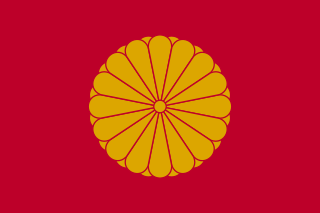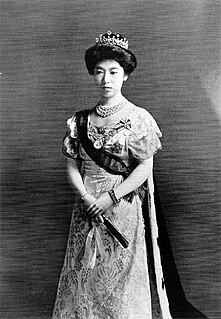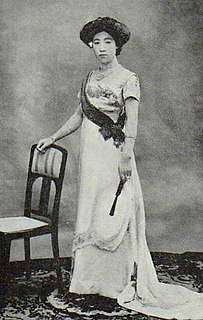
The Emperor of Japan is the monarch and the head of the Imperial Family of Japan. Under the Constitution of Japan, he is defined as the symbol of the Japanese state and the unity of the Japanese people, and his position is derived from "the will of the people with whom resides sovereign power". Imperial Household Law governs the line of imperial succession. The emperor is immune from prosecution by the Supreme Court of Japan. He is also the head of the Shinto religion. In Japanese, the emperor is called Tennō, literally "Heavenly sovereign". The Japanese Shinto religion holds him to be the direct descendant of the solar goddess Amaterasu. The emperor is also the head of all national Japanese orders, decorations, medals, and awards. In English, the use of the term Mikado (帝/御門) for the emperor was once common but is now considered obsolete.

The Tale of Genji is a Japanese manga version of Murasaki Shikibu's The Tale of Genji by Waki Yamato.

Empress Kōjun, born Princess Nagako, was a member of the Imperial House of Japan, the wife of Emperor Shōwa (Hirohito) and the mother of Shigeko Higashikuni, Princess Sachiko Hisa-nomiya, Kazuko Takatsukasa, Atsuko Ikeda, the Emperor Emeritus Akihito, Prince Masahito Hitachi-nomiya and Takako Shimazu.

Empress Dowager Cixi, of the Manchu Yehe Nara clan, was a Chinese noblewoman, concubine and later regent who effectively controlled the Chinese government in the late Qing dynasty for 47 years, from 1861 until her death in 1908. Selected as a concubine of the Xianfeng Emperor in her adolescence, she gave birth to a son, Zaichun, in 1856. After the Xianfeng Emperor's death in 1861, the young boy became the Tongzhi Emperor, and she assumed the role of co-empress dowager, alongside the Emperor's widow, Empress Dowager Ci'an. Cixi ousted a group of regents appointed by the late emperor and assumed the regency along with Ci'an, who later died under mysterious circumstances. Cixi then consolidated control over the dynasty when she installed her nephew as the Guangxu Emperor at the death of her son, the Tongzhi Emperor, in 1875. This was contrary to the traditional rules of succession of the Qing dynasty that had ruled China since 1644.

The Daoguang Emperor, born Mianning, was the seventh Emperor of the Qing dynasty, and the sixth Qing emperor to rule over China proper, reigning from 1820 to 1850. His reign was marked by "external disaster and internal rebellion," that is, by the First Opium War, and the beginning of the Taiping Rebellion which nearly brought down the dynasty. The historian Jonathan Spence characterizes the Daoguang Emperor as a "well meaning but ineffective man" who promoted officials who "presented a purist view even if they had nothing to say about the domestic and foreign problems surrounding the dynasty."

The Jiaqing Emperor, whose personal name is Yongyan, was the sixth emperor of the Manchu-led Qing dynasty, and the fifth Qing emperor to rule over China proper, from 1796 to 1820. He was the 15th son of the Qianlong Emperor. During his reign, he prosecuted Heshen, the corrupt favorite of his father, and attempted to restore order within the Qing Empire while curbing the smuggling of opium into China.
Empress dowager is the English language translation of the title given to the mother or widow of an East Asian emperor.

Empress Teimei, born Sadako Kujō, was the wife of Emperor Taishō and the mother of Emperor Shōwa of Japan. Her posthumous name, Teimei, means "enlightened constancy".

The Empress of Japan is the title given to the wife of the Emperor of Japan. In Japanese, the empress consort is called Kōgō (皇后). The current empress consort is Empress Masako, who ascended the throne with her husband on 1 May 2019. The term "Empress of Japan" can also mean a female imperial ruler.

Empress Dowager Shōken, born Masako Ichijō, was the wife and adviser of Emperor Meiji of Japan. She is also known under the technically more correct name Empress Shōken. She was one of the founders of the Japanese Red Cross Society, whose charity work was known throughout the First Sino-Japanese War.
The ranks of imperial consorts have varied over the course of Chinese history but remained important throughout owing to its importance in management of the inner court and in imperial succession, which ranked heirs according to the prominence of their mothers in addition to their strict birth order. Regardless of the age, however, it is common in English translation to simplify these hierarchy into the three ranks of Empress, consorts, and concubines. It is also common to use the term "harem", an Arabic loan word used in recent times to refer to imperial women's forbidden quarters in many countries. In later Chinese dynasties, these quarters were known as the back palace. In Chinese, the system is called the Rear Palace System.

Emperor Meiji, also called Meiji the Great or Meiji the Good, was the 122nd emperor of Japan according to the traditional order of succession. Reigning from 3 February 1867 until his death on 30 July 1912, and the first monarch of the Empire of Japan, he presided over the Meiji era, and instigated the Meiji Restoration, a series of rapid changes that witnessed Japan's transformation from an isolationist, feudal state to an industrialized world power.

Empress Dowager Eishō was the empress consort of Emperor Kōmei of Japan. She is also known under the technically incorrect name Empress Eishō.

Princess Nobuko Asaka, born Nobuko, Princess Fumi, was the twelfth child and eighth daughter of Emperor Meiji of Japan, and the fifth child and fourth daughter of Sono Sachiko, the Emperor's fifth concubine.
Events in the year 1877 in Japan.
Events in the year 1874 in Japan.
Events in the year 1876 in Japan.

Sono Sachiko (園祥子) was the fifth concubine of Emperor Meiji of Japan. Although Meiji was the last Japanese emperor to have more than one consort, the official role at court was not abolished until 1924; surviving concubines remained as members of the imperial family in retirement. In 2005 Prince Tomohito of Mikasa urged the revival of concubinage to address problems related to male-only primogeniture in the current order of Japanese imperial succession.
Hamuro Mitsuko was the first concubine of Emperor Meiji, and the mother of his first child Wakamitsuteru-hiko no Mikoto (稚瑞照彦尊). Wakamitsuteru-hiko no Mikoto was stillborn, and Mitsuko died of complications from his delivery five days later. Mitsuko was assisted in the delivery by Kusumoto Ine, the first woman doctor of western medical training in Japan.
Hashimoto Natsuko was the second concubine of Emperor Meiji, and the mother of his first daughter Wakatakayori-hime no Mikoto (稚高依姫尊). Wakatakayori-hime no Mikoto was stillborn, and Natsuko died of complications from her delivery.












